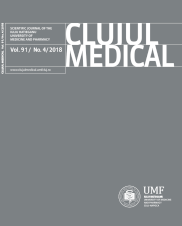Sterilization Protocol for Porous dental implants made by Selective Laser Melting
DOI:
https://doi.org/10.15386/cjmed-987Keywords:
selective laser melting, dental implants, porous implants, sterilizationAbstract
Background and aims. Although dental implants are widely and successfully used, failure rates because of bacterial colonization are still high. Adequate fabrication and sterilization techniques as well as proper management of infectious complications represent a constant field of interest and research. In this study, we focused our attention on implants with controlled porosity produced by Selective Laser Melting (SLM). The difficulty to sterilize porous implantable devices is well known and finding an adequate sterilization protocol represents a challenge worldwide. Before testing the biological and mechanical properties of porous implants, a preliminary study in order to determine a correct sterilization protocol must be conducted.
Our aim was to establish a valid sterilization protocol for porous titanium alloy dental implants, as such protocols are not officially available yet.
Methods. Twenty dental implants were fabricated from a titanium alloy by SLM. Ten of them were made using a 150W laser beam (porosity of 1% - group A) and the rest using a 75W laser beam (porosity of 23% - Group B), all of them with a non-defined internal structure. The implants were initially sterilized (5 from group A and 5 from group B, using dry heat - 180°C for 2 hours; the rest using steam sterilization - 121 °C for15 min) and then spent 18 hours in culture media with developing bacteria (Bacillus cereus (ATCC 11778), Staphylococcus aureus (ATCC 49444), Enterococcus faecalis (ATCC 29212), Listeria monocytogenes (ATCC 19114), three Gram negative bacteria: Escherichia coli (ATCC 25922), Salmonella typhimurium (ATCC 14028) and Pseudomonas aeruginosa (ATCC 27853). The first ten implants (5 from group A and 5 from group B) were then sterilized with dry heat and the others with steam. After sterilization, they were all placed in sterile culture media in order to observe if any bacterial growth were present.
Results. The culture media was observed 18 hours after the sterilized implants were placed inside. No bacterial growth was observed.
Conclusions. Our tests reached their aims of defining a protocol to sterilize porous implants. Future tests regarding biological and mechanical aspects of these implants may now follow.
Downloads
Additional Files
Published
How to Cite
Issue
Section
License
The authors are required to transfer the copyright of the published paper to the journal. This is done by agreeing to sign the Copyright Assignment Form. Whenever the case, authors are also required to send permissions to reproduce material (such as illustrations) from the copyright holder.

The papers published in the journal are licensed under a Creative Commons Attribution-NonCommercial-NoDerivatives 4.0 International License.

